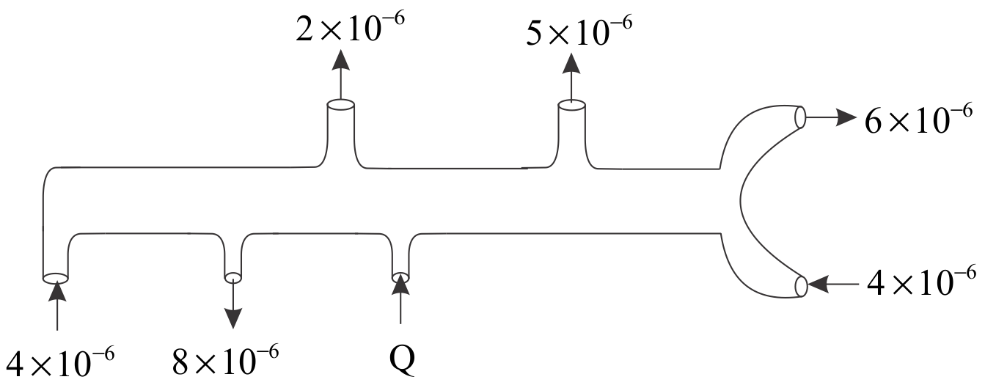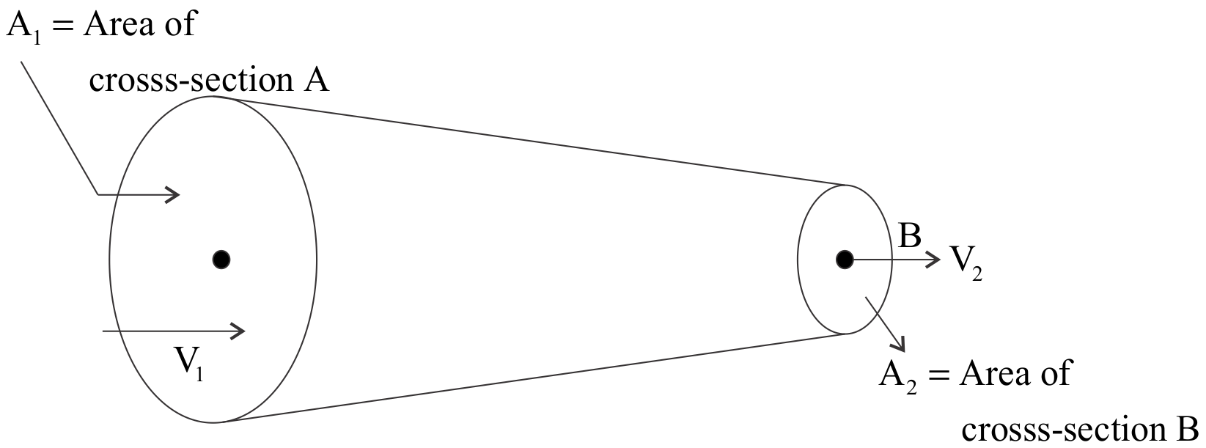
The pipe shows the volume flow rate of an ideal liquid at a certain time and its direction. What is the value of \[Q\] in \[\dfrac{{{m^3}}}{s}\] ? ( Assume steady state and equal area of cross- section at each point).

(A) $10 \times {10^{ - 6}}$
(B) $11 \times {10^{ - 6}}$
(C) $13 \times {10^{ - 6}}$
(D) $18 \times {10^{ - 6}}$
Answer
218.4k+ views
Hint: Apply the equation of continuity at all sections . The volume flowing inside the pipe will be equal to the volume flowing outside the pipe . All other values ( at each opening ) are given and this is how it can be calculated .
Complete step by step solution: The above problem will be solved by applying a continuity equation. The equation of continuity is based on conservation of mass . It states that the volume entering the pipe will be equal to the volume exiting the pipe ( if there aren’t any frictional losses) .

Suppose we have two sections A and B as shown in the diagram .
${V_1},{V_2}$ are the velocities of each section A and B respectively .
${A_1},{A_2}$ are the corresponding areas of cross- sections .
So according to equation of continuity:
${A_1}{V_1} = {A_2}{V_2}$ ……..(i)
The flow rate of liquid is expressed in terms of area and velocity. So eq(i) can be written as :
${Q_1} = {Q_2}$
In the above question, flow rate through each cross- section is given .
Flow rate incoming= flow rate outgoing
We have:
$
{Q_{in}} = {Q_{out}} \\
(4 \times {10^{ - 6}}) + (4 \times {10^{ - 6}}) + Q = (2 \times {10^{ - 6}}) + (5 \times {10^{ - 6}}) + (8 \times {10^{ - 6}}) + (6 \times {10^{ - 6}}) \\
Q = 13 \times {10^{ - 6}} \\
$
We have got the answer . The correct option is C.
Note: We need to keep in mind that in this derivation we have neglected the loss due to friction . If friction were to be present there will be slight loss in the volume of the liquid .
Complete step by step solution: The above problem will be solved by applying a continuity equation. The equation of continuity is based on conservation of mass . It states that the volume entering the pipe will be equal to the volume exiting the pipe ( if there aren’t any frictional losses) .

Suppose we have two sections A and B as shown in the diagram .
${V_1},{V_2}$ are the velocities of each section A and B respectively .
${A_1},{A_2}$ are the corresponding areas of cross- sections .
So according to equation of continuity:
${A_1}{V_1} = {A_2}{V_2}$ ……..(i)
The flow rate of liquid is expressed in terms of area and velocity. So eq(i) can be written as :
${Q_1} = {Q_2}$
In the above question, flow rate through each cross- section is given .
Flow rate incoming= flow rate outgoing
We have:
$
{Q_{in}} = {Q_{out}} \\
(4 \times {10^{ - 6}}) + (4 \times {10^{ - 6}}) + Q = (2 \times {10^{ - 6}}) + (5 \times {10^{ - 6}}) + (8 \times {10^{ - 6}}) + (6 \times {10^{ - 6}}) \\
Q = 13 \times {10^{ - 6}} \\
$
We have got the answer . The correct option is C.
Note: We need to keep in mind that in this derivation we have neglected the loss due to friction . If friction were to be present there will be slight loss in the volume of the liquid .
Recently Updated Pages
Chemical Properties of Hydrogen - Important Concepts for JEE Exam Preparation

JEE General Topics in Chemistry Important Concepts and Tips

JEE Atomic Structure and Chemical Bonding important Concepts and Tips

JEE Amino Acids and Peptides Important Concepts and Tips for Exam Preparation

JEE Extractive Metallurgy Important Concepts and Tips for Exam Preparation

Algebra Made Easy: Step-by-Step Guide for Students

Trending doubts
JEE Main 2026: Application Form Open, Exam Dates, Syllabus, Eligibility & Question Papers

Derivation of Equation of Trajectory Explained for Students

Hybridisation in Chemistry – Concept, Types & Applications

Understanding the Angle of Deviation in a Prism

Understanding Collisions: Types and Examples for Students

Understanding Atomic Structure for Beginners

Other Pages
JEE Advanced Marks vs Ranks 2025: Understanding Category-wise Qualifying Marks and Previous Year Cut-offs

Units And Measurements Class 11 Physics Chapter 1 CBSE Notes - 2025-26

NCERT Solutions For Class 11 Physics Chapter 8 Mechanical Properties Of Solids

Motion in a Straight Line Class 11 Physics Chapter 2 CBSE Notes - 2025-26

NCERT Solutions for Class 11 Physics Chapter 7 Gravitation 2025-26

How to Convert a Galvanometer into an Ammeter or Voltmeter




